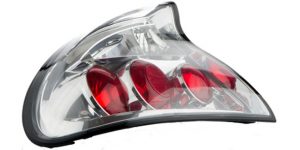
Heat Staking Improves Component Quality for Taillight Manufacturers
Durability is of chief importance to auto component manufacturers.
When engaged in high-volume production of taillights for consumer automobiles, manufacturers need to engineer the process to minimize the chance of accidentally damaging delicate inner components. This is especially true when building taillights, where the two leading welding methods produce less-than-ideal results from a quality control perspective.
Auto manufacturers have tried using many different welding processes over the decades – General Motors famously adopted ultrasonic welding in the 1970s, but gave up on the process when new technology made better, more consistent results possible.
Now, most automakers and component manufacturers rely on one of two component welding processes. However, heat staking is a little-known third option that directly addresses the weaknesses of these two popular methods.
How Do Taillight Manufacturers Assemble Components Today?
In modern production facilities, most automakers rely on one of two technologies.
- Snaps: One of the cheapest and easiest methods to implement, snaps are small protruding plastic joints that fit neatly into the latest automobiles’ sleek designs and contoured features. This is technically not a welding process, since no welding takes place – the protruding part simply snaps into its receptacle and stays there until force or vibration wrests it free.
This low-cost method lets automakers install taillights cheaply, but it does not offer the kind of durability or quality control performance that manufacturers need. Snaps are prone to break when exposed to unexpected force, making the resulting part extremely delicate. Should a single snap break, the entire component becomes unusable, resulting in significant productivity losses on the factory floor.
- Fasteners: Fasteners offer a stronger bond than snaps, but tend to produce similar problems on the factory floor. The most common fasteners in use are steel screws, which are prone to consistency problems. Automated joining systems have a tendency to split the boss and making the component unusable, typically due to variations in parts tolerances and the accuracy of the torque control. Even a small difference in the amount of torque used can ruin an otherwise perfectly good taillight.
LED taillights present another problem. LED technology is very delicate and responds poorly to vibration. Power screwdrivers and Ultrasonic assembly methods – tend to vibrate all of the components, producing unpredictable results as the light’s inner diodes react poorly to this vibration and fail to function properly.
How Can Heat Staking Create an Effective Bond?
Taillight manufacturers who use heat staking to weld their components benefit from a secure bond of reliable consistency. This technology uses precise thermal control and motion to form heat stake posts to hold parts together tightly without generating vibration or excessive heat into the LEDs of the assembly. It is an ideal solution for taillight manufacturers looking to improve quality control issues because it minimizes the number of products that fail quality checks. Heat staking also has a much greater ability to accommodate part variations, while still producing a high-quality and reliable taillight assembly.
This heat staking technology is already a popular option for connecting infotainment display components and other dashboard accessories in automobile interiors. It quickly creates a strong and reliable assembly without damaging sensitive electronics in the process, making it an increasingly valuable trick of the trade for the automobile industry.